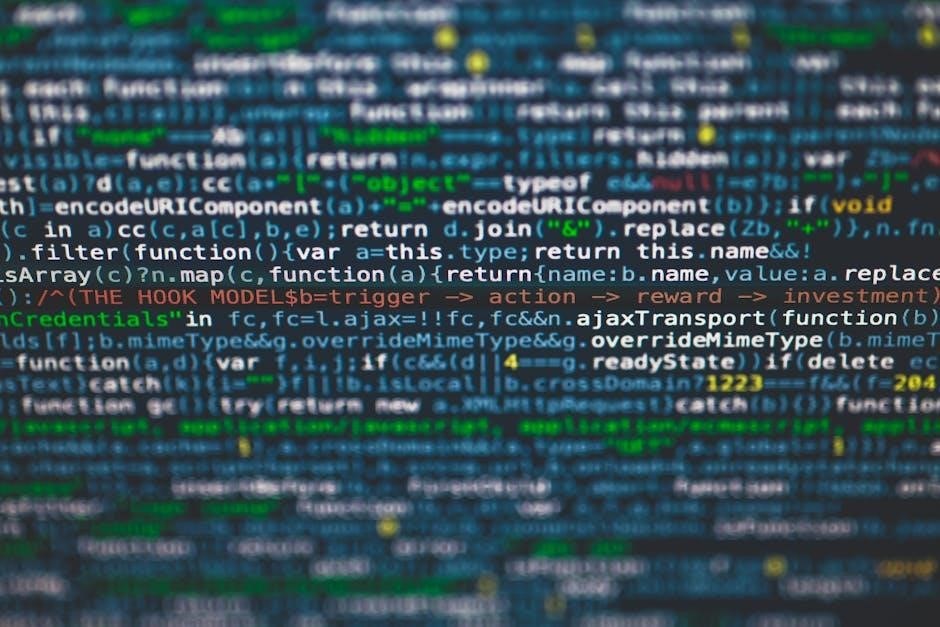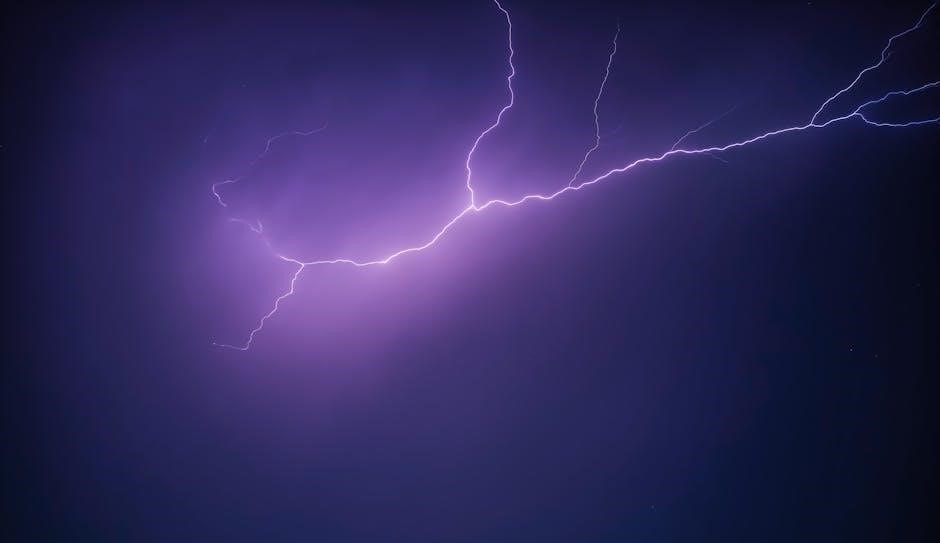Understanding Dometic fridge error codes is essential for troubleshooting and resolving issues efficiently․ These codes provide insights into specific malfunctions, guiding users to quick solutions and preventing further damage․
1․1 Importance of Understanding Error Codes
Understanding Dometic fridge error codes is crucial for identifying and resolving issues promptly․ These codes act as a diagnostic tool, providing insights into specific malfunctions․ By deciphering them, users can address problems before they escalate, saving time and money․ Error codes like CF, E1, E2, U1, and W1 indicate issues ranging from sensor faults to cooling system failures․ Recognizing these codes empowers users to perform basic troubleshooting, potentially avoiding costly repairs․ This knowledge also enhances maintenance routines, ensuring optimal fridge performance and food safety․ Regular checks and understanding error codes can prevent unexpected breakdowns and extend the appliance’s lifespan․ Always refer to the official Dometic PDF guide for accurate interpretations and solutions․
1․2 Overview of Dometic Fridge Models and Error Codes
Dometic offers a wide range of fridge models, including the RUA, RM, and CR series, each designed for specific needs․ These models feature advanced electronic controls that display error codes to indicate malfunctions․ The RUA series, known for absorption refrigeration, often shows codes like CF and U1, related to cooling issues․ The RM series, including models like RM1350, may display E1 and E2 codes, signaling sensor or electrical problems․ CR models and other variants have unique codes tied to their operation․ Referencing the official Dometic PDF guide provides model-specific solutions, ensuring accurate troubleshooting and maintenance․ Understanding these codes is vital for optimal performance and longevity․

Common Dometic Fridge Error Codes
Dometic fridges display various error codes like CF, E1, E2, and U1, indicating issues from sensor malfunctions to cooling system problems․ Understanding these codes helps diagnose and resolve issues quickly․
2․1 CF Error Code: Meaning and Troubleshooting
The CF error code on Dometic fridges typically indicates a communication fault between the control board and the cooling unit․ This can occur due to loose connections, faulty wiring, or a malfunctioning control module․ To troubleshoot, first, ensure all electrical connections are secure․ If the issue persists, check the cooling unit’s operation and consult the official PDF guide for detailed diagnostic steps․ In severe cases, professional assistance may be required to replace faulty components and restore proper communication․
2․2 E1 and E2 Error Codes: Causes and Solutions
The E1 and E2 error codes on Dometic fridges are related to temperature sensor issues․ E1 typically indicates a problem with the refrigerator compartment’s NTC sensor, while E2 points to a malfunction in the freezer compartment’s sensor․ Causes include faulty sensors, loose connections, or damaged wiring․ To resolve these errors, check the sensors for proper connection and functionality․ If a sensor is defective, replace it with an authorized part․ Ensure all wiring is secure and free from damage․ If issues persist, consult the official Dometic error codes PDF guide for advanced troubleshooting or contact a professional technician․
2․3 U1 Error Code: Understanding the Issue
The U1 error code on Dometic fridges signifies a communication failure within the CAN (Controller Area Network) system․ This occurs when there’s an interruption in data exchange between the control board and other components․ Common causes include faulty wiring, loose connections, or a malfunctioning control module․ To address this, inspect all wiring harnesses for damage or corrosion․ Ensure all connections are secure․ If the issue persists, resetting the system or replacing the control module may be necessary․ Refer to the Dometic error codes PDF guide for detailed instructions and troubleshooting steps to resolve the U1 error effectively․
2․4 W1 and W2 Error Codes: Water and Cooling Issues
The W1 and W2 error codes on Dometic fridges indicate issues related to water temperature and cooling performance․ W1 typically points to a problem with the water heating system or temperature sensor, while W2 suggests a malfunction in the cooling unit or its control․ Common causes include faulty NTC sensors, poor water circulation, or blocked ventilation․ To resolve these errors, inspect the water system for leaks or obstructions and ensure proper airflow around the cooling unit․ If issues persist, consult the Dometic error codes PDF guide for detailed troubleshooting steps to restore optimal cooling and water functionality․
2․5 Other Common Error Codes (ERR1, ERR2, etc․)
Beyond specific codes like CF or E1, Dometic fridges may display generic errors such as ERR1 or ERR2․ These codes often indicate system malfunctions that aren’t tied to a single component․ ERR1 might signify a communication error between the control board and sensors, while ERR2 could point to issues with the compressor or electrical connections․ Always refer to the Dometic error codes PDF guide for precise diagnostics․ Resetting the fridge by disconnecting power for 30 seconds can sometimes clear these errors, but persistent issues may require professional intervention to ensure proper functionality and safety․

How to Retrieve Dometic Fridge Error Codes
Accessing Dometic fridge error codes involves using the display panel or specific button combinations․ Refer to the PDF guide for model-specific instructions to retrieve and interpret codes accurately․
3․1 Using the Display Panel to Identify Codes
The display panel on your Dometic fridge is a key tool for identifying error codes․ Modern models feature a TFT or LED screen that highlights fault codes with warning symbols․ When an issue arises, the middle section of the display turns red, showing the specific error code․ Some models also emit a beep to signal the presence of an error; By referencing the official PDF guide, you can decode these messages, understanding whether the issue is related to temperature sensors, cooling performance, or other critical systems․ This feature ensures timely diagnosis and resolution of problems, preventing further complications․ Regular checks using the display panel can help maintain your fridge’s optimal performance and extend its lifespan․ Additionally, understanding the color-coded alerts, such as red for critical errors, allows you to prioritize repairs effectively․ Utilize the display panel’s error indicators to stay informed and ensure your Dometic fridge operates efficiently․ Always refer to the PDF manual for precise interpretations and solutions tailored to your model․
3․2 Manual Button Combinations to Retrieve Codes
Retrieving error codes on older Dometic fridge models often requires specific button combinations․ By pressing and holding the ‘Set’ and ‘Up’ buttons simultaneously for 5-10 seconds, the display switches to error mode․ Some models may need the ‘Power’ and ‘Down’ buttons held for a similar duration․ Upon releasing, the display will show active error codes, such as ‘E1’ or ‘CF,’ which can then be referenced in the PDF guide․ If the error persists after troubleshooting, professional assistance may be necessary․ Always follow the sequence carefully to avoid resetting the fridge unnecessarily․ Ensure the unit is powered on during this process for accurate code retrieval․ This method is especially useful for models without advanced digital displays, providing a reliable way to diagnose issues․ Remember to release the buttons immediately after hearing a beep to prevent unintended power downs․ Consulting the official manual ensures you use the correct combination for your specific model, avoiding potential misdiagnosis․ Regular practice with these button sequences can streamline future troubleshooting efforts, saving time and reducing frustration․ Stay proactive by familiarizing yourself with these manual operations to keep your Dometic fridge functioning smoothly․ Always verify the codes against the PDF guide for accurate interpretations and solutions․ This approach empowers users to address issues confidently, whether at home or on the go․
3․3 Differences in Error Code Retrieval Across Models
Dometic fridge models vary in error code retrieval methods․ For RUA series, press and hold the ‘Set’ and ‘Up’ buttons for 5 seconds․ RM models require the ‘Power’ and ‘Down’ buttons․ CR models often use a single button press․ Displays differ too; some show codes instantly, while others need multiple steps․ LED indicators on older models may flash error codes without a display․ Always consult the PDF guide for model-specific instructions to avoid confusion․ This ensures accurate code retrieval and effective troubleshooting․ Understanding these differences is key to diagnosing issues correctly and efficiently across various Dometic fridge models․

Troubleshooting Dometic Fridge Error Codes
Troubleshooting Dometic fridge error codes involves resetting the appliance, checking temperature sensors, ensuring proper ventilation, and addressing electrical or power supply issues․ This helps diagnose and fix problems effectively․
4․1 Resetting the Fridge and Clearing Error Codes
Resetting your Dometic fridge can often clear error codes and restore normal operation․ Press and hold the temperature button for 5-10 seconds until a beep sounds․ This resets the control panel․ For some models, switch off the fridge, unplug it for 30 minutes, and restart it․ If the error persists, ensure the issue is addressed before clearing the code again․ Resetting does not fix underlying problems but allows the fridge to resume operation temporarily․ Always check the source of the error to prevent future occurrences․
4․2 Checking Temperature Sensors and NTCs
Temperature sensors and NTCs (Negative Temperature Coefficient thermistors) play a crucial role in regulating your Dometic fridge’s performance․ If an error code indicates a sensor issue, inspect the sensors for damage or misplacement․ Use a multimeter to check resistance values, ensuring they align with specifications․ Clean any debris affecting sensor accuracy and verify proper connections․ Incorrect readings can lead to cooling inefficiencies or error codes like CF or U1․ If a sensor is faulty, replace it with a genuine Dometic part to maintain optimal operation and prevent further issues;
4․3 Ensuring Proper Ventilation and Cooling
Proper ventilation is vital for your Dometic fridge’s efficiency and to prevent error codes․ Ensure the ventilation grilles are clear of obstructions, as blocked airflow can cause overheating and trigger errors like W1 or W2․ Regularly clean the condenser coils and check for dust buildup․ Maintain adequate space around the fridge for air circulation․ If installed in a confined area, consider upgrading ventilation to prevent heat accumulation․ Improper cooling can lead to system malfunctions, so always follow Dometic’s installation guidelines for optimal performance and error-free operation․
4․4 Electrical and Power Supply Issues
Electrical and power supply issues are common causes of Dometic fridge error codes․ Check for stable voltage and ensure connections are secure․ Faulty wiring or low power can trigger errors like E1 or E2․ Use a voltage stabilizer if experiencing power fluctuations․ Verify the circuit breaker hasn’t tripped and all fuses are intact․ For gas models, ensure the LP supply is adequate․ If issues persist, consult a professional․ Always refer to the Dometic fridge error codes PDF guide for specific solutions related to electrical malfunctions, ensuring your fridge operates smoothly without recurring issues․

Preventive Maintenance to Avoid Error Codes
Regular cleaning, inspecting sensors, and ensuring proper ventilation can prevent Dometic fridge error codes․ Schedule maintenance to keep your refrigerator running efficiently and avoid costly repairs․
5․1 Cleaning and Inspecting the Fridge Regularly
Regular cleaning and inspection of your Dometic fridge are crucial for maintaining its performance and preventing error codes․ Dust buildup in vents or condenser coils can restrict airflow, leading to temperature control issues and potential malfunctions․ Inspect temperature sensors and electrical connections for damage or corrosion․ Clean the exterior and interior surfaces to ensure proper heat dissipation and operation․ Additionally, check door seals for tightness to maintain internal temperatures․ Addressing these areas regularly can help prevent common errors like E1 and E2, which often relate to sensor or connection problems․ A well-maintained fridge operates efficiently and reduces the likelihood of error codes, ensuring reliability and longevity․
5․2 Ensuring Proper Installation and Leveling
Proper installation and leveling of your Dometic fridge are vital to prevent error codes and ensure optimal performance․ An improperly leveled fridge can cause cooling inefficiencies, leading to issues like U1 or W1 errors․ Always follow the manufacturer’s installation guidelines to ensure the fridge is level and securely mounted․ Incorrect installation can strain internal components, such as the cooling unit, and disrupt normal operation․ Regularly check the fridge’s leveling, especially after movement or reinstallation, to maintain proper function and avoid potential malfunctions․ A correctly installed and leveled fridge minimizes the risk of error codes and enhances overall reliability․
5․3 Regular Checks of Gas and Electrical Connections
Regular inspections of gas and electrical connections are crucial for preventing Dometic fridge error codes․ Faulty connections can lead to issues like U1000 or U1001 codes, indicating communication errors․ Ensure all gas lines are secure and free from leaks, as improper connections can disrupt the cooling process․ Similarly, check electrical connections for loose wires or corrosion, which may cause power supply issues․ Refer to the Dometic fridge error codes PDF guide for specific troubleshooting steps; Maintaining these connections ensures safe and efficient operation, minimizing the risk of critical errors and extending the appliance’s lifespan․

When to Call a Professional
Consult a professional for critical Dometic fridge error codes, especially those indicating internal component failures or complex system issues․ Expert intervention ensures safety and prevents further damage․
6․1 Identifying Critical Errors Requiring Expert Help
Certain Dometic fridge error codes indicate severe issues that demand professional attention․ These include codes related to internal component failures, such as faulty cooling units or sensors․ If you encounter codes like U1000 or U1001, which point to CAN communication errors, or W01, indicating a defective NTC fridge compartment, immediate expert help is necessary․ These errors can lead to system shutdowns or unsafe operating conditions․ Always refer to the official Dometic PDF guide for accurate diagnosis and contact authorized service centers for reliable repairs․
6․2 Authorized Service Centers for Dometic Fridges
For critical errors, contact Dometic-authorized service centers to ensure professional repairs․ These centers specialize in diagnosing issues like faulty sensors or cooling units․ Technicians are trained to handle advanced problems and use genuine parts․ You can locate authorized centers through Dometic’s official website or the PDF guide․ Regular maintenance by these experts can prevent future issues․ Always verify the center’s authorization to avoid unauthorized repairs, which may void your warranty․ Refer to your model’s manual for specific service recommendations, such as for RM1350 or RUA series models․

Downloading the Dometic Fridge Error Codes PDF Guide
Access the official Dometic fridge error codes PDF guide online․ This comprehensive manual provides detailed troubleshooting solutions, ensuring quick fixes and maintaining optimal performance for your Dometic refrigerator․
7․1 Steps to Access the Official PDF Manual
To access the Dometic fridge error codes PDF guide, visit the official Dometic website or authorized service portals․ Use the search bar to find “Dometic fridge error codes PDF” or specific model manuals like RUA or RM series․ Download the guide directly from trusted sources to ensure authenticity․ The PDF manual includes detailed error code explanations, troubleshooting steps, and model-specific solutions․ Refer to the guide for quick fixes and professional recommendations․ This resource is indispensable for resolving issues efficiently and maintaining your refrigerator’s performance․
7․2 Navigating the PDF Guide for Error Code Solutions
Navigate the Dometic fridge error codes PDF guide by using the table of contents or index to locate specific error codes․ Each code is listed with its meaning, possible causes, and step-by-step solutions․ The guide includes diagrams and troubleshooting checklists for model-specific issues․ Additionally, sections on preventive maintenance and advanced diagnostics provide comprehensive support․ Ensure to reference the correct model section for accurate information․ This structured approach helps users quickly identify and resolve issues, minimizing downtime and ensuring optimal appliance performance․

Model-Specific Error Codes
Different Dometic fridge models, like the RUA and RM series, have unique error codes tied to specific issues․ The PDF guide details diagnostics for each model, ensuring accurate troubleshooting․
8․1 RUA Series Error Codes and Solutions
The RUA series of Dometic fridges often displays specific error codes like CF, E1, and E2, indicating issues with sensors or the cooling system․ For example, CF may signal a faulty LED, while E1 and E2 point to temperature sensor malfunctions․ Solutions include resetting the fridge, checking sensor connections, or ensuring proper ventilation․ W1 and W2 errors may indicate water or cooling issues, requiring inspection of the water system or ice buildup․ Regular maintenance, like cleaning vents and ensuring proper installation, can prevent these errors․ Refer to the PDF guide for model-specific troubleshooting steps․
8․2 RM Series Error Codes and Troubleshooting
The RM series Dometic fridges may display error codes related to temperature control and cooling performance․ Common issues include faulty NTC sensors, indicated by codes like E1 or E2, which require sensor replacement or connection checks․ U1 errors often point to communication faults in the control system․ Additionally, W1 and W2 codes suggest water-related problems or insufficient cooling, which may involve cleaning condenser coils or ensuring proper ventilation․ The PDF guide provides detailed diagnostics for RM models, emphasizing the importance of authorized service for complex repairs to maintain efficiency and prevent further issues․
8․3 CR and Other Model-Specific Codes
Dometic CR model error codes often relate to specific malfunctions, such as faulty sensors or cooling issues․ For instance, the CF11 error may indicate LED or display problems, while ERR1 or ERR2 signals a device malfunction requiring professional intervention․ Other models, like the RUA series, may show codes tied to temperature sensors or gas connections․ Always consult the official PDF guide for model-specific diagnostics, as procedures vary across series․ Proper repair by authorized technicians ensures optimal performance and prevents further damage, especially for complex systems like absorption refrigeration units․ Regular maintenance can help avoid these issues altogether․

Understanding the Display and LED Indicators
The display shows error codes and status messages, while LED indicators use colors like red to signal issues․ Refer to the manual for detailed interpretations and solutions․
9․1 Interpreting Flashing LEDs and Error Messages
Faults are indicated by error codes and LED signals on the display․ A flashing red LED often signals critical issues like cooling malfunctions or sensor problems․ The middle section of the display highlights errors with a red banner and specific codes, such as CF or E1, guiding users to the root cause․ Refer to the manual for precise interpretations, as codes like W01 indicate NTC defects in the fridge compartment․ Understanding these indicators helps users address issues promptly, ensuring efficient troubleshooting and maintaining optimal fridge performance․
9․2 Color Codes and Their Meanings (Red, Green, etc․)
Dometic fridges use color-coded LED indicators to signal system status․ A red LED flash typically indicates an error, such as a faulty NTC sensor or cooling issue, requiring immediate attention․ Green lights often signify normal operation or successful troubleshooting․ Yellow may indicate warnings, while blue might show cooling activation․ Understanding these colors helps users quickly assess the fridge’s condition and take appropriate actions, ensuring efficient diagnosis and maintenance․ Always consult the official PDF guide for precise color code interpretations to avoid misdiagnosis and ensure proper functionality․

Advanced Troubleshooting Techniques
Advanced troubleshooting involves diagnosing complex issues like CAN communication errors and gas operation faults․ It requires specialized tools and a deep understanding of the system’s inner workings․
10․1 Checking the Cooling Unit and Orifice Size
Examining the cooling unit and orifice size is critical for optimal performance․ Incorrect orifice sizing can reduce cooling efficiency, while a malfunctioning cooling unit may trigger error codes like U1 or CF․ Ensure the unit operates within specified parameters and inspect for blockages or damage․ Referencing the Dometic fridge error codes PDF guide can help identify specific issues related to cooling performance and provide detailed steps for adjustment or replacement․ Always follow manufacturer guidelines to maintain proper function and avoid further complications․
10․2 Addressing CAN Communication Errors (U1000, U1001)
CAN communication errors, such as U1000 and U1001, indicate issues with the internal network of your Dometic fridge․ These codes often appear due to faulty connections or malfunctioning sensors․ To address these errors, inspect the wiring and connections for damage or corrosion․ Ensure all components are securely linked and functioning properly․ Resetting the system or updating software may resolve the issue․ For detailed diagnostic steps, consult the Dometic fridge error codes PDF guide, which outlines specific troubleshooting procedures for CAN-related problems․
10․3 Solving Issues Related to Gas and Electric Operation
Gas and electric operation issues in Dometic fridges often trigger specific error codes․ Check gas connections for leaks and ensure proper ventilation․ Verify electrical connections are secure and free from damage․ If using LP-gas, ensure the supply is adequate․ Resetting the fridge or consulting the error codes PDF guide can help diagnose issues․ For persistent problems, professional servicing may be required to maintain safety and efficiency․ Always follow manufacturer guidelines to avoid further complications․ Regular maintenance can prevent such issues from arising․

